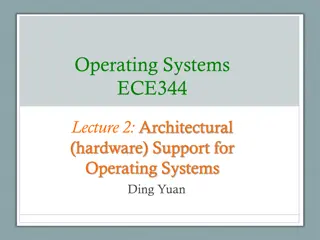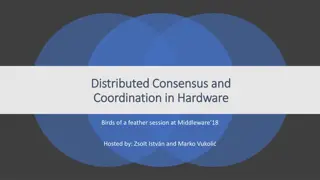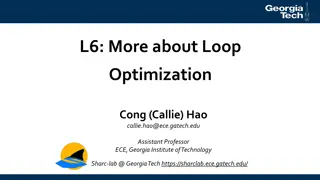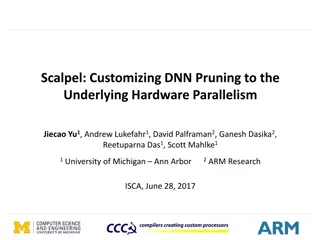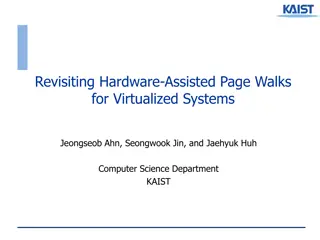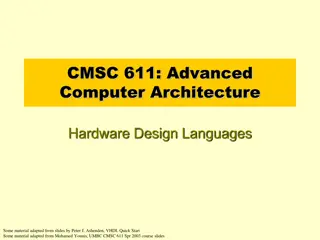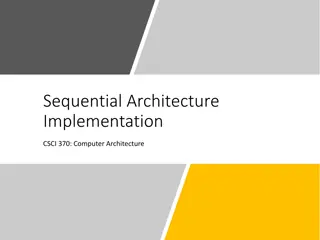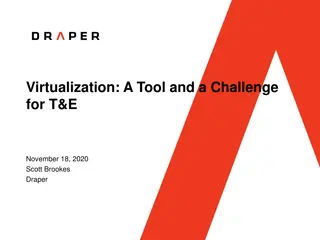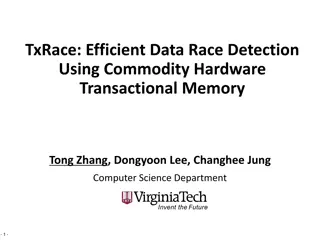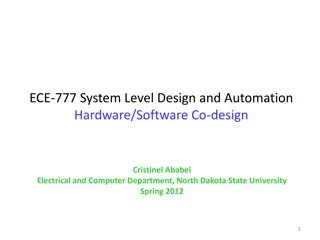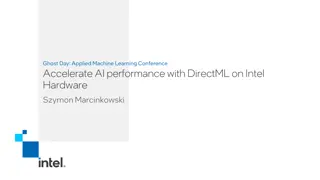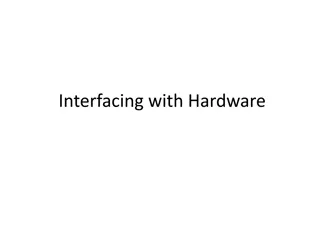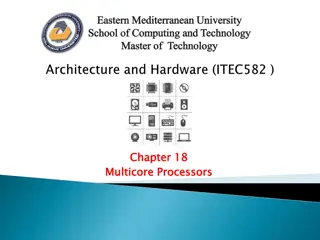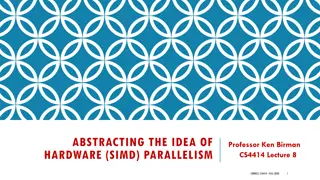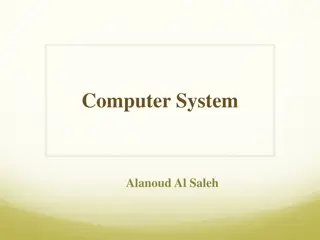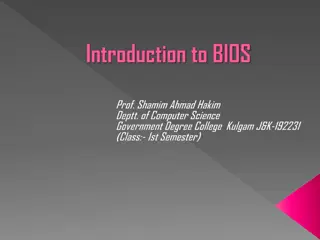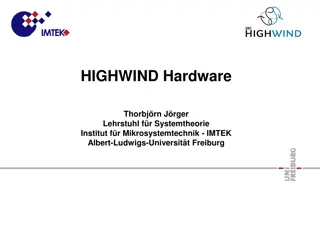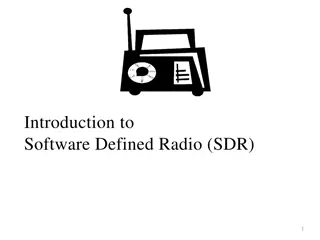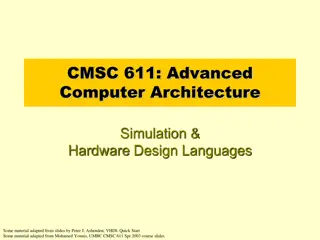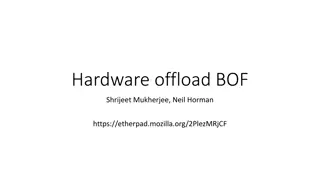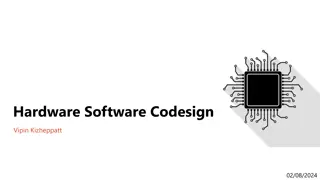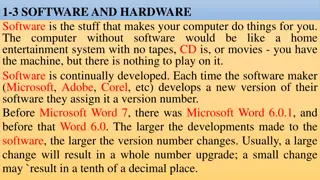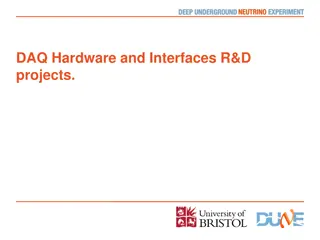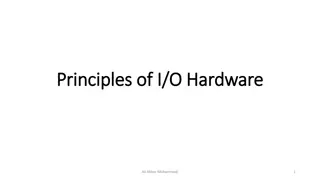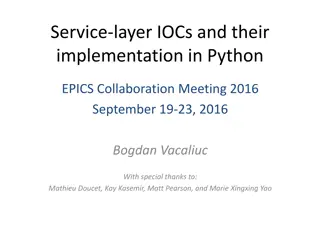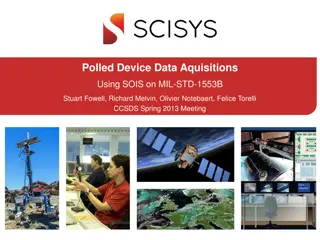Leveraging Specialized Hardware for Enhanced Performance
Delve into the realm of specialized hardware, from the times of von Neumann architecture to modern GPU reliance, highlighting the evolution, deficiencies, and strategies for maximizing efficiency in computational tasks.
Download Presentation

Please find below an Image/Link to download the presentation.
The content on the website is provided AS IS for your information and personal use only. It may not be sold, licensed, or shared on other websites without obtaining consent from the author. Download presentation by click this link. If you encounter any issues during the download, it is possible that the publisher has removed the file from their server.
E N D
Presentation Transcript
Chapter 4 Pioneering Specialized Hardware Chapter 4 Pioneering Specialized Hardware Using standard hardware Using specialized hardware Improving your hardware Interacting with the environment
One of the reasons for the failure of early AI efforts was a lack of suitable hardware. Fortunately, standard, off-the-shelf hardware can overcome the speed issue for many problems today. von Neumann architecture: Separating memory from computing, creating a wonderfully generic processing environment. von Neumann bottleneck People are working to create a better environment in which the hardware can operate Enhancing the capabilities of the underlying hardware Using specialized sensors In fact, the computer understands nothing; all the credit goes to the persons who program the computer.
Relying on Standard Hardware Relying on Standard Hardware Even if you can t ultimately perform production-level work by using standard hardware, you can get far enough along with your experimental and preproduction code to create a working model that will eventually process a full dataset.
Understanding the standard hardware The architecture (structure) of the standard PC hasn t changed since John von Neumann first proposed it in 1946. The PC you use today has the same architecture as devices created long ago; they re simply more capable. Almost every device you can conceive of today has a similar architecture, despite having different form factors, bus types, and essential capabilities.
Describing standard hardware deficiencies The modularity provided by the von Neumann architecture comes with some serious deficiencies: von Neumann bottleneck Single points of failure Single-mindedness Tasking
Relying on new computational techniques Many data scientists rely on the Graphical Processing Unit (GPU) to speed execution of complex code. Neural Magic Buy just a few high-cost machines to perform research and create an application. Run the resulting application on as many low-cost systems as needed to satisfy user requirements.
Using GPUs Using GPUs After creating a prototypical setup to perform the tasks required to simulate human thought on a given topic, you may need additional hardware to provide sufficient processing power to work with the full dataset required of a production system. A common way is to use Graphic Processing Units (GPUs) in addition to the central processor of a machine.
Considering the von Neumann bottleneck The von Neumann bottleneck is a natural result of using a bus to transfer data between the processor, memory, long-term storage, and peripheral devices. Solutions: Caching Processor caching Prefetching Using specialty RAM
Defining the GPU The original intent of a GPU was to process image data quickly and then display the resulting image onscreen. A GPU moves graphics processing from the motherboard to the graphics peripheral board. What really sets a GPU apart is that a GPU typically contains hundreds or thousands of, contrasted with just a few cores for a CPU.
An A100 GPU can host up to 80GB of RAM and has up to 8,192 FP32 (single-precision floating-point format) CUDA (Compute Unified Device Architecture) Cores per full GPU. CUDA is a parallel computing platform and Application Programming Interface (API) developed by NVIDIA. Even though the CPU provides more general purpose functionality, the GPU performs calculations incredibly fast and can move data from the GPU to the display even faster.
Considering why GPUs work well The GPUs today excel at performing the specialized tasks associated with graphics processing, including working with vectors. All those cores performing tasks in parallel really speed AI calculations. After people understood that GPUs could replace a host of computer systems stocked with CPUs, they could start moving forward with a variety of AI projects.
Working with Deep Learning Processors (DLPs) Working with Deep Learning Processors (DLPs) Researchers engage in a constant struggle to discover better ways to train, verify, and test the models used to create AI applications. A GPU is beneficial only because it can perform matrix manipulation quickly, and on a massively parallel level.
Defining the DLP A Deep Learning Processor (DLP) is simply a specialized processor that provides some advantages in training, verifying, testing, and running AI applications. Most DLPs follow a similar pattern by providing: Separate data and code memory areas Separate data and code buses Specialized instruction sets Large on-chip memory Large buffers to encourage data reuse patterns
Using the mobile Neural Processing Unit (NPU) A number of mobile devices, notably those by Huawei and Samsung, have a Neural Processing Unit (NPU) in addition to a general CPU to perform AI predictive tasks using models such as Artificial Neural Networks (ANNs) and Random Forests (RFs). An NPU is specialized in these ways: It accelerates the running of predefined models (as contrasted to training, verification, and testing) It s designed for use with small devices It consumes little power when contrasted to other processor types It uses resources, such as memory, efficiently
Accessing the cloud-based Tenser Processing Unit (TPU) Google specifically designed the Tensor Processing Unit (TPU) in 2015 to more quickly run applications built on the TensorFlow framework. However, it s different in another way in that it s an Application- Specific Integrated Circuit (ASIC), rather than a full-blown CPU-type chip. The differences are important: An ASIC can perform only one task, and you can t change it. Because of its specialization, an ASIC is typically much less expensive than a CPU. Most ASIC implementations are much smaller than the same implementation created with a CPU. Compared to a CPU implementation, an ASIC is more power efficient. ASICs are incredibly reliable.
Creating a Specialized Processing Environment Deep learning and AI are both non-von Neumann processes, according to many experts. Designing hardware that matches the software is quite appealing. The Defense Advanced Research Projects Agency (DARPA) undertook one such project in the form of Systems of Neuromorphic Adaptive Plastic Scalable Electronics (SyNAPSE).
Increasing Hardware Capabilities Increasing Hardware Capabilities The CPU still works well for business systems or in applications in which the need for general flexibility in programming outweighs pure processing power. In the future, you may see one of two kinds of processors used in place of these standards: Application-Specific Integrated Circuits (ASICs) Field Programmable Gate Arrays (FPGAs)
Adding Specialized Sensors Adding Specialized Sensors The use of filtered static and dynamic data enables an AI to interact with humans in specific ways today. In some cases, humans actually want their AI to have superior or different senses.
Devising Methods to Interact with the Devising Methods to Interact with the Environment Environment An AI that is self-contained and never interacts with the environment is useless. The traditional method of providing inputs and outputs is directly through data streams that the computer can understand, such as datasets, text queries, and the like. Interactions can take many forms. Physical interactions are also on the rise.


